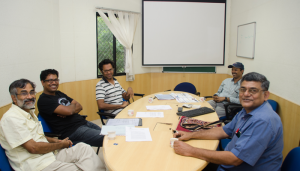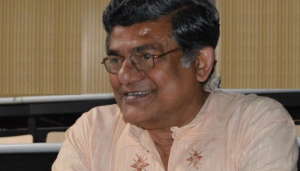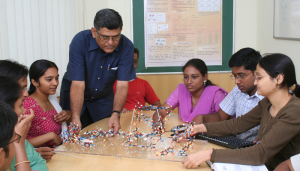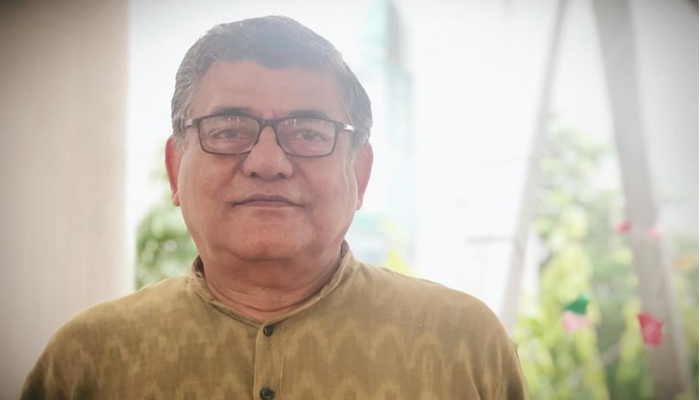They say it takes a village to raise a child. If you liken the institute IIIT to a child, it has taken several, well-meaning, passionate administrators and faculty like Prof. Abhijit Mitra to raise this one. Often the face behind collective, unpopular early decisions, he’s been known for standing ground on the principles that make this institute stand apart from mere academic laurels. As he shifts gears and slows down to embark on a new chapter next year, we catch up with him and listen to the vignettes he shares from his journey so far.
“I am a Chemist. I neither knew any Biology nor any Computer Science, both of which I learned here at the age of 50,” says Prof. Abhijit Mitra by way of introduction. As someone who was once head of the Centre for Computational Natural Sciences and Bioinformatics (CCNSB) (Initially known as the Bioinformatics Research Centre – BiRC)and instrumental in setting it up from scratch, this declaration is intriguing. All at once, I settle down for a long, warm conversation with the avuncular figure.
IIT Chemistry
A set of unrelated events set the ball in motion towards Prof. Mitra’s life-long tryst with Chemistry. It began with the gifting of a Chemistry set by his father when he was all of 11. “I was fascinated, no doubt. But It was nothing very serious at the time,” says Prof. Mitra. It was in class 9 however, that a Chemistry teacher gathered interested students and went out of his way explaining certain concepts and the principles behind them in free periods. There was no looking back after this. Eschewing the trend then (and now!), Prof. Mitra refused to appear for the over-subscribed JEE (joint entrance exam). “I did not want to do engineering,” he says matter-of-factly. Fortunately for him, his stellar performance in the Higher Secondary board exams not only earned him the fifth position board-wise but also the National Science Talent Search scholarship covering all educational expenses in the field of Science. “It was that year the IITs declared that the first 10 meritorious students from every Board would automatically get selected to the IIT of their choice,” says Prof. Mitra with a chuckle. Needless to say, there was considerable familial pressure, but Prof. Mitra’s mind was set on a Chemistry program. Luckily for both parties, IIT Kharagpur had a BSc programme which he enrolled for. It was at IIT Kanpur however where he went on to pursue his MS and then later his PhD in Chemistry from. “In those days, IIT Kanpur was also known as IIT Chemistry. And at one point, there were eight Bhatnagar awardees simultaneously in the Chemistry department,” says Prof. Mitra with pride while speaking of the institute’s acclaim in the field.
Dal Mein Kaala
Notwithstanding the peer pressure and quite the norm at the time, Prof. Mitra turned down an offer of a Post-Doc in the US, choosing instead to work for a college in Kanpur. And all the while committing to the social sector in his spare time. “When I said I want to work in the villages, people were a little shocked and maybe even suspicious. Speculation was rife over why I didn’t catch the bus at the right time, when everyone else was focusing on their careers. Unfortunately, social work is construed as a very negative thing,” explains Prof. Mitra.
Neki Aur Pooch Pooch
Meanwhile upon the invitation of Dr. Vijayraghavan, current Principal Scientific Advisor to the Govt. of India, Prof. Mitra spent a summer at the then newly founded National Centre for Biological Sciences (NCBS) in Bangalore. It was the time that Bioinformatics as an interdisciplinary field was coming into its own. “I underwent a Fellowship there (at NCBS). And fortuitously soon after, I heard that IIIT Hyderabad had kickstarted a Bioinformatics course and were looking for qualified faculty,” says Prof. Mitra. The initial offer was to teach a single summer course but apparently the feedback was so good, that instantaneously he was asked if he could join as a permanent faculty. “Neki aur pooch pooch (Why seek the permission of the one who you are doing good to),” laughs Prof. Mitra. That was July 2002. For Prof. Mitra who had been looking to relocate from Kanpur, the offer couldn’t have come sooner. “Academically, I was frustrated. Socially also, I couldn’t continue in the same vein due to the kind of politics going on,” says the professor honestly. What was originally a diploma program at IIITH soon morphed into a 3-year degree course with several of the students who enrolled preferring the latter. He speaks fondly of one of his first students, Naveena Yanamala, “a good student”, who, having completed her PhD from Carnegie Mellon University, is now working as a scientist in National Institutes of Health (NIH). She is also currently an adjunct faculty at IIITH. “In the initial phase, Prof. Nita Parekh joined us. There was a retired biologist called Prof. Rameshwar who taught the Biology part of the courses. Then later, Prof. Harjinder Singh joined too,” reminisces Prof. Mitra. When momentum picked up at the center, there was a steady hum in terms of research and projects, automatically drawing in great faculty, taking CCNSB to its current stature.

Failure Not An Option
“I was 50 years old at the time, and the only advantage I had was that Bioinformatics is an interdisciplinary subject. Since I understand Chemistry reasonably well, I thought this is the place where I can collaborate with different people,” says the professor. Hence all his projects are collaborative ones and so are most of his PhD students. But how difficult was it to acquire new skills at 50? “I wouldn’t say it was easy, I wouldn’t say it was difficult. But it was definitely challenging. And the only thing that took me through was the thought that I couldn’t afford to fail!” exclaims Prof. Mitra. The supportive atmosphere at the institute helped tremendously too. “Unlike in other places where you are questioned about why you want to do this or that…here, I was given the go-ahead. Normally at the age of 50, if you tell someone you want to learn this, they will just laugh and throw you out. They didn’t do that to me here,” recalls Prof. Mitra, saying that it worked out very well, surprising himself too.

Human Values
Given his socio-political interests and engagements, Prof. Mitra found resonance with the thought process of the founding members of the institute in the creation of the Human Values course. “I had a lot in common with Prof. Rajeev Sangal’s visions regarding education, as it is. But it was in 2004-05 that a gentleman named Ganesh Bagariya visited campus who was onto something he called Jeevan Vidya. The Human Values course as we know it today is based on that,” explains Prof. Mitra. The basic premise of the course is to give students a holistic education not just by teaching them a specific set of skills but to assist them in realizing what they want to do and why. “Skills tell you how to do something either when somebody tells you (what to do) or you decide for yourself. So the general trend is that you find out what sort of skills are needed by people. And then you learn that skill and approach them for a job. Essentially, what is to be done is decided by others.” Terming his involvement in Human Values on campus and subsequent induction into the Student Life Chair committee as a ‘journey’, it led to an overhaul in the manner with which student issues were handled until then. Once, when some instances of ragging were brought to notice, the concerned students were dealt with firm disciplinary action in terms of working at an NGO where the activities opted for were treated as courses and credits subsequently transferred. While there is zero tolerance on certain issues, Paschatap (remorse) is advocated. Not believing in rules and punishment, the professor says that if the punished person doesn’t think he deserves it, it serves no purpose. “On the other hand, if a person realizes his mistake, then that punishment is not necessary at all. So it’s a Catch-22. The only way out is through paschatap.”
Student Life
An important issue that brings a satisfactory smile on the professor’s face is the way ragging was dealt with on campus. “We could change the paradigm of ragging to no-ragging. We could change it within a couple of years into a paradigm of red carpet welcoming,” says Prof. Mitra. This involved the formation of a student apex body which was essentially a set of senior students working in conjunction with the faculty and the administrative staff. The team that was set up in this manner contacted all potential new-joinees at least a month before the actual admission so that the process of settling in on campus would be smooth. “We often forget that the worst thing to do when we are dealing with large numbers or between communities, is the we-them paradigm. If we can set a proper example, the right peers to guide the student community, then the errant ones will automatically get contained. It only required a lot of work, a lot of effort and continued effort,” says Prof. Mitra.

What stands out in his role as SLC chair is Prof. Mitra’s hugely unpopular decision, suggested and fully supported by the then Director Prof Rajeev Sangal, to halt the spending of big monies for inviting celebrities on campus as a manner of attracting footfall to the cultural event, Felicity. There was almost a protest of sorts and a wanton display of disinterest to stall the planning and organization from unrolling any further. “But I could really convince a large number of them that if people come to IIIT because you’ve brought a celebrity then it’s almost like.. Ganeshji gadhe ke upar leke log le jaa rahe hai, sab log pranaam kar rahe hai, gadha soch raha hai ki hum ko kar rahe hai. Log IIIT ke liye aayenge ya celebrity ke liye aayenge..” (If you bring Ganeshji on a donkey and everyone prostrates before it, the donkey thinks the reverence is for him. Similarly, should people come to campus for the institute or for the celebrity?). It took some time but his reasoning that what matters is the environment, the welcome accorded to other participants, competitions of high calibre, coupled with the presence of great judges, seemed to strike a cord with the angry student organizers and helped defuse the volatile situation.
Social Activism
As conversation veers towards the professor’s other passions, he relaxes visibly while elapsing into a more frequent torrent of Hindi. Shrugging off apprehensions of being labelled an “urban naxalite”, he holds forth on what he would like to do post the stint at IIITH: the study of Loka Vidya or what he refers to as the People’s Knowledge Movement in Kolkata. Prof. Mitra laments that under the guise of development and progress, the farmer, the artisan or even a housewife’s innate knowledge is being made a mockery of. “The amount of knowledge which is responsible for sustaining their rich heritage (and not just technical knowledge) is there with them, and it is immense. It just goes if nobody gives any respect whatsoever. And in this knowledge inbuilt is bhaicharaor Brotherhood.”
Looking Back
“If there is some message I can give to the young generation, it is this : ki hum ne bachpan se apna man ka karne ka chaha aur man ka kiya, Doobara karne ko mauka milega toh phir wohi wohi karte rahenge…(If I had a chance to do it all over again, I would do it). The best phase of course was at IIITH because of the kind of support I got, the love and affection from the staff..I don’t know how 17 years have gone by…it went like a song.” Empowering people remains the professor’s goal. “I’m not going to take vanaprastha((laughs))..I’m going to be very active, but just not in a professional way.”

Sarita Chebbi is a compulsive early riser. Devourer of all news. Kettlebell enthusiast. Nit-picker of the written word especially when it’s not her own.


Dear Sarita,
Ruchi Shah says:it’s so very well written. Thank you so much for capturing uncle’s journey so beautifully. There’s so much to learn always. Love and hugs
Very well written. Helps me travel down the memory lane some 4-5 years back.
Shubhajit Roy Chowdhury says:Great and true in every aspect
Dhananjay Bhattacharyya says: